Functions of animals in children’s english literature
Animals, wild and domestic, have shared a long history with humans. Some of them are not only
pets but they are also extremely close friends with humans. In some big capitalist countries like
England and France, laws are enforced to protect animals and require owners to take care of them
like their relatives. In literature, anthropomorphism – a term for the depiction of animals with human
attributes in literary works – has a long history in world cultures. For children in particular, stories
that have animals that act like humans have contributed to the children’s inspiration and enjoyment
for reading. This paper aimed to demonstrate several main roles of animals in some popular
children’s literary works.
Keywords: English literature; roles of animals, children.
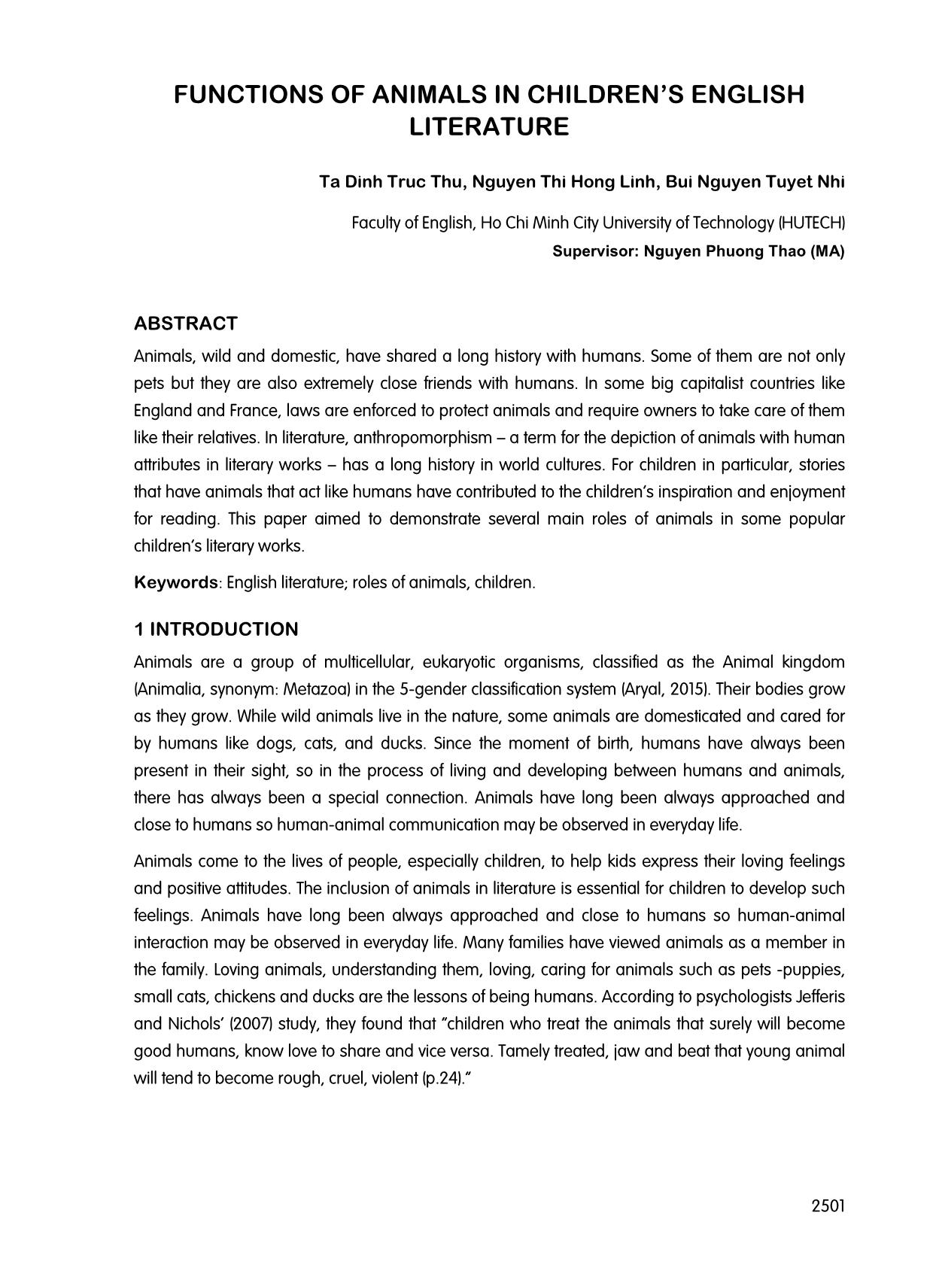
Trang 1
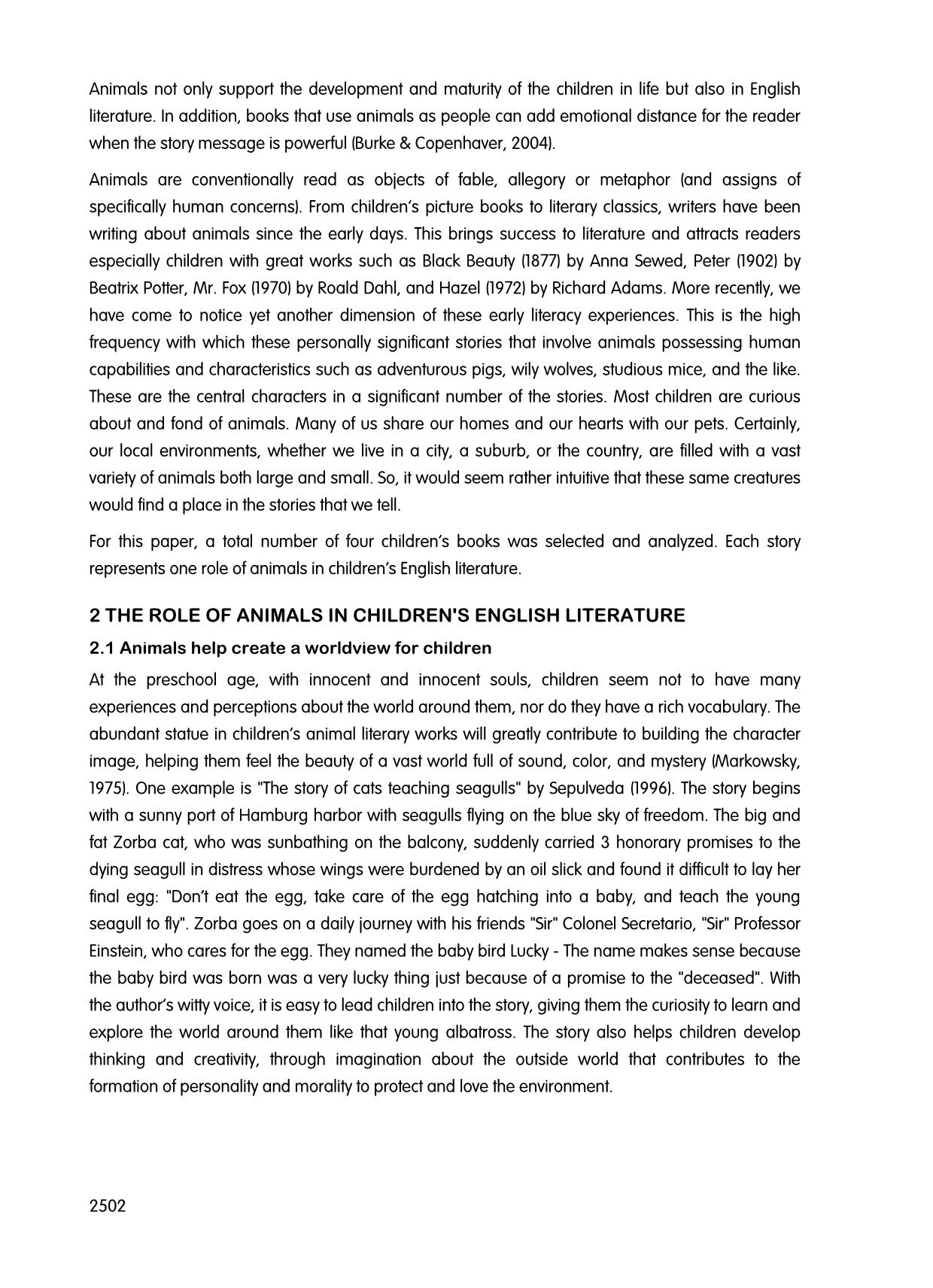
Trang 2
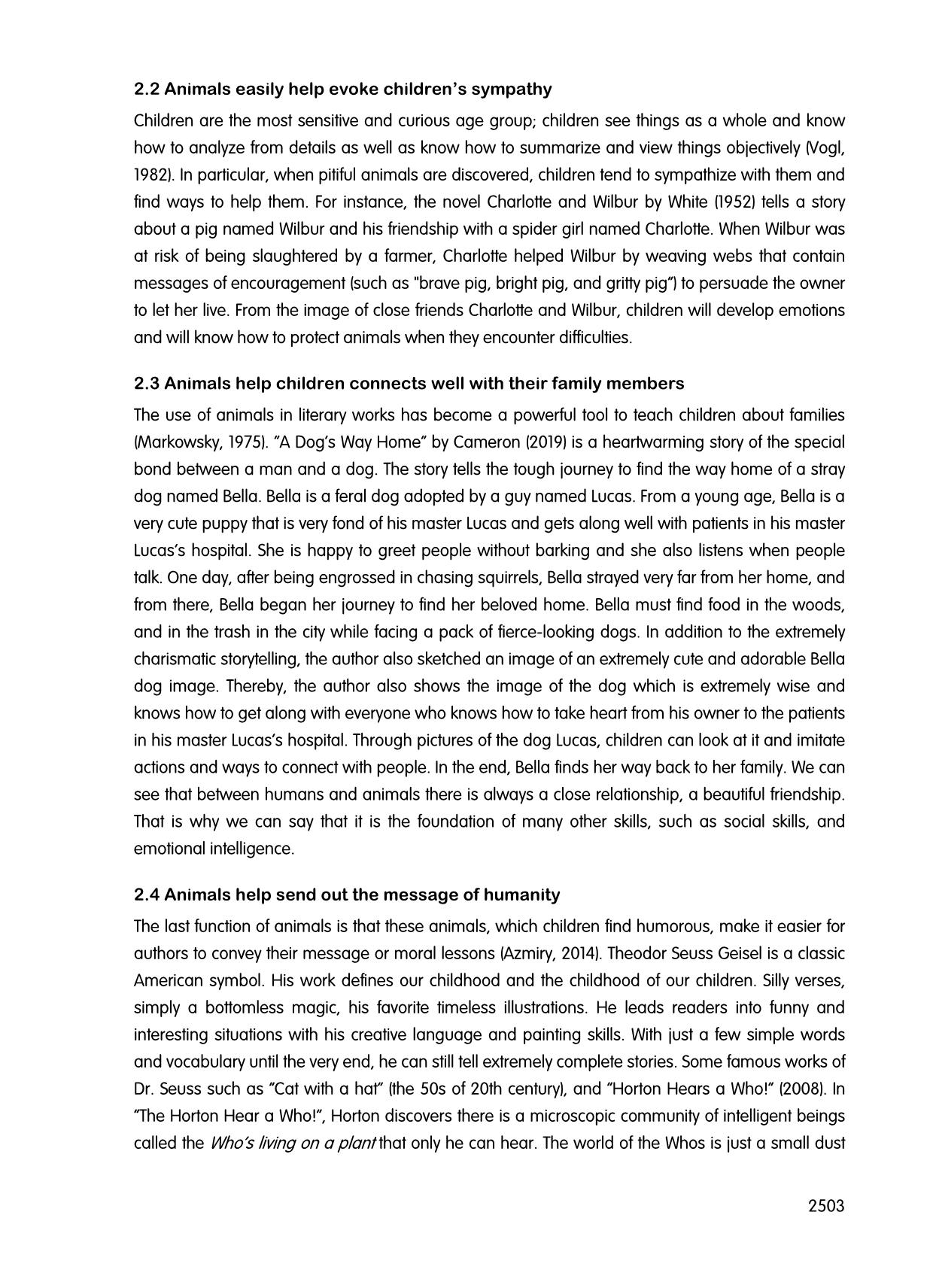
Trang 3
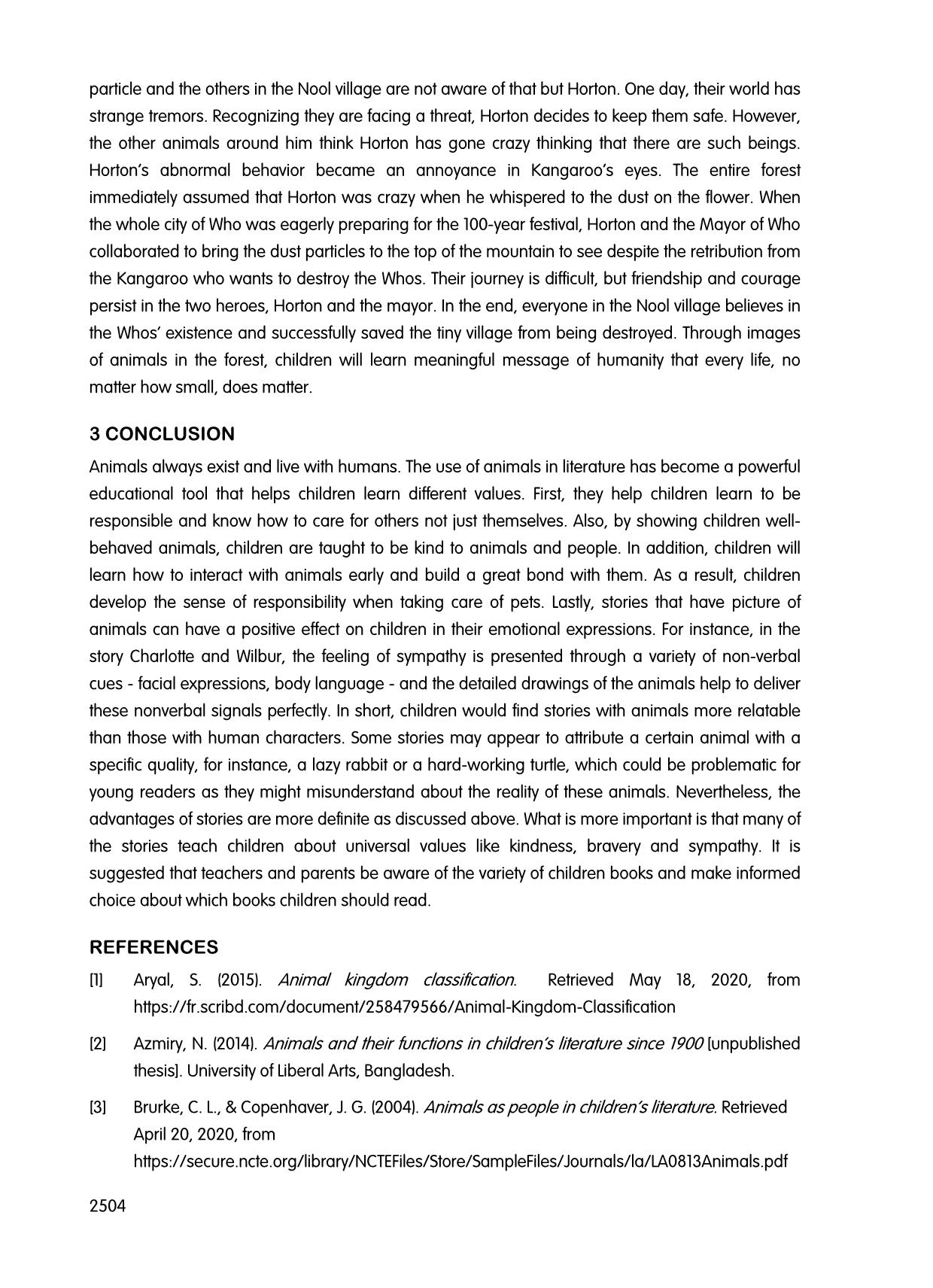
Trang 4
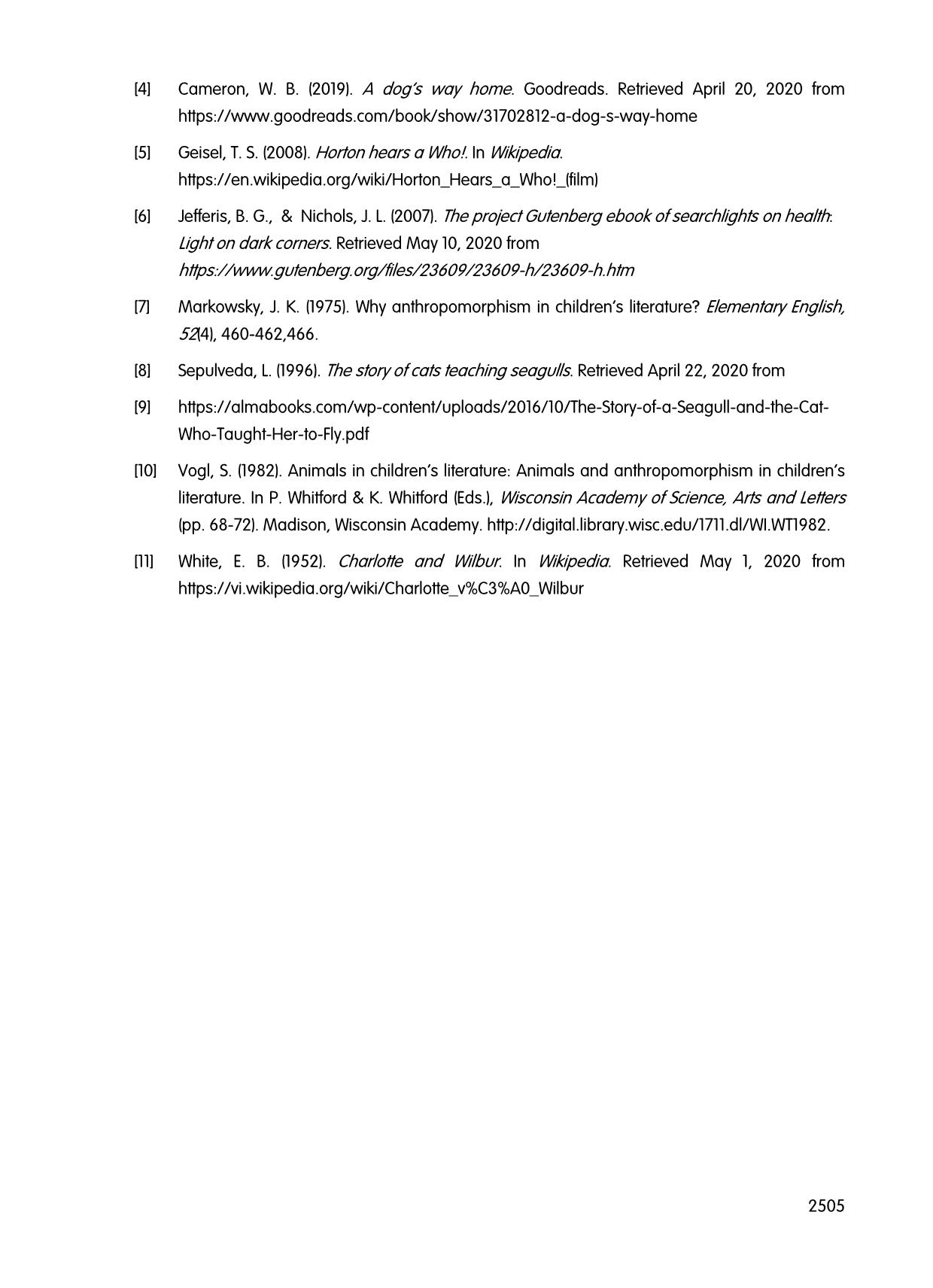
Trang 5
Tóm tắt nội dung tài liệu: Functions of animals in children’s english literature
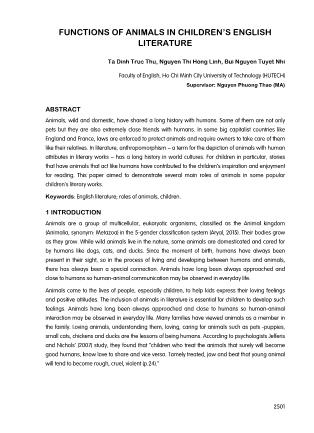
2501 FUNCTIONS OF ANIMALS IN CHILDREN’S ENGLISH LITERATURE Ta Dinh Truc Thu, Nguyen Thi Hong Linh, Bui Nguyen Tuyet Nhi Faculty of English, Ho Chi Minh City University of Technology (HUTECH) Supervisor: Nguyen Phuong Thao (MA) ABSTRACT Animals, wild and domestic, have shared a long history with humans. Some of them are not only pets but they are also extremely close friends with humans. In some big capitalist countries like England and France, laws are enforced to protect animals and require owners to take care of them like their relatives. In literature, anthropomorphism – a term for the depiction of animals with human attributes in literary works – has a long history in world cultures. For children in particular, stories that have animals that act like humans have contributed to the children’s inspiration and enjoyment for reading. This paper aimed to demonstrate several main roles of animals in some popular children’s literary works. Keywords: English literature; roles of animals, children. 1 INTRODUCTION Animals are a group of multicellular, eukaryotic organisms, classified as the Animal kingdom (Animalia, synonym: Metazoa) in the 5-gender classification system (Aryal, 2015). Their bodies grow as they grow. While wild animals live in the nature, some animals are domesticated and cared for by humans like dogs, cats, and ducks. Since the moment of birth, humans have always been present in their sight, so in the process of living and developing between humans and animals, there has always been a special connection. Animals have long been always approached and close to humans so human-animal communication may be observed in everyday life. Animals come to the lives of people, especially children, to help kids express their loving feelings and positive attitudes. The inclusion of animals in literature is essential for children to develop such feelings. Animals have long been always approached and close to humans so human-animal interaction may be observed in everyday life. Many families have viewed animals as a member in the family. Loving animals, understanding them, loving, caring for animals such as pets -puppies, small cats, chickens and ducks are the lessons of being humans. According to psychologists Jefferis and Nichols’ (2007) study, they found that ‚children who treat the animals that surely will become good humans, know love to share and vice versa. Tamely treated, jaw and beat that young animal will tend to become rough, cruel, violent (p.24).‛ 2502 Animals not only support the development and maturity of the children in life but also in English literature. In addition, books that use animals as people can add emotional distance for the reader when the story message is powerful (Burke & Copenhaver, 2004). Animals are conventionally read as objects of fable, allegory or metaphor (and assigns of specifically human concerns). From children’s picture books to literary classics, writers have been writing about animals since the early days. This brings success to literature and attracts readers especially children with great works such as Black Beauty (1877) by Anna Sewed, Peter (1902) by Beatrix Potter, Mr. Fox (1970) by Roald Dahl, and Hazel (1972) by Richard Adams. More recently, we have come to notice yet another dimension of these early literacy experiences. This is the high frequency with which these personally significant stories that involve animals possessing human capabilities and characteristics such as adventurous pigs, wily wolves, studious mice, and the like. These are the central characters in a significant number of the stories. Most children are curious about and fond of animals. Many of us share our homes and our hearts with our pets. Certainly, our local environments, whether we live in a city, a suburb, or the country, are filled with a vast variety of animals both large and small. So, it would seem rather intuitive that these same creatures would find a place in the stories that we tell. For this paper, a total number of four children’s books was selected and analyzed. Each story represents one role of animals in children’s English literature. 2 THE ROLE OF ANIMALS IN CHILDREN'S ENGLISH LITERATURE 2.1 Animals help create a worldview for children At the preschool age, with innocent and innocent souls, children seem not to have many experiences and perceptions about the world around them, nor do they have a rich vocabulary. The abundant statue in children's animal literary works will greatly contribute to building the character image, helping them feel the beauty of a vast world full of sound, color, and mystery (Markowsky, 1975). One example is "The story of cats teaching seagulls" by Sepulveda (1996). The story begins with a sunny port of Hamburg harbor with seagulls flying on the blue sky of freedom. The big and fat Zorba cat, who was sunbathing on the balcony, suddenly carried 3 honorary promises to the dying seagull in distress whose wings were burdened by an oil slick and found it difficult to lay her final egg: "Don't eat the egg, take care of the egg hatching into a baby, and teach the young seagull to fly". Zorba goes on a daily journey with his friends "Sir" Colonel Secretario, "Sir" Professor Einstein, who cares for the egg. They named the baby bird Lucky - The name makes sense because the baby bird was born was a very lucky thing just because of a promise to the "deceased". With the author’s witty voice, it is easy to lead children into the story, giving them the curiosity to learn and explore the world around them like that young albatross. The story also helps children develop thinking and creativity, through imagination about the outside world that contributes to the formation of personality and morality to protect and love the environment. 2503 2.2 Animals easily help evoke children’s sympathy Children are the most sensitive and curious age group; children see things as a whole and know how to analyze from details as well as know how to summarize and view things objectively (Vogl, 1982). In particular, when pitiful animals are discovered, children tend to sympathize with them and find ways to help them. For instance, the novel Charlotte and Wilbur by White (1952) tells a story about a pig named Wilbur and his friendship with a spider girl named Charlotte. When Wilbur was at risk of being slaughtered by a farmer, Charlotte helped Wilbur by weaving webs that contain messages of encouragement (such as "brave pig, bright pig, and gritty pig‛) to persuade the owner to let her live. From the image of close friends Charlotte and Wilbur, children will develop emotions and will know how to protect animals when they encounter difficulties. 2.3 Animals help children connects well with their family members The use of animals in literary works has become a powerful tool to teach children about families (Markowsky, 1975). ‚A Dog's Way Home‛ by Cameron (2019) is a heartwarming story of the special bond between a man and a dog. The story tells the tough journey to find the way home of a stray dog named Bella. Bella is a feral dog adopted by a guy named Lucas. From a young age, Bella is a very cute puppy that is very fond of his master Lucas and gets along well with patients in his master Lucas's hospital. She is happy to greet people without barking and she also listens when people talk. One day, after being engrossed in chasing squirrels, Bella strayed very far from her home, and from there, Bella began her journey to find her beloved home. Bella must find food in the woods, and in the trash in the city while facing a pack of fierce-looking dogs. In addition to the extremely charismatic storytelling, the author also sketched an image of an extremely cute and adorable Bella dog image. Thereby, the author also shows the image of the dog which is extremely wise and knows how to get along with everyone who knows how to take heart from his owner to the patients in his master Lucas's hospital. Through pictures of the dog Lucas, children can look at it and imitate actions and ways to connect with people. In the end, Bella finds her way back to her family. We can see that between humans and animals there is always a close relationship, a beautiful friendship. That is why we can say that it is the foundation of many other skills, such as social skills, and emotional intelligence. 2.4 Animals help send out the message of humanity The last function of animals is that these animals, which children find humorous, make it easier for authors to convey their message or moral lessons (Azmiry, 2014). Theodor Seuss Geisel is a classic American symbol. His work defines our childhood and the childhood of our children. Silly verses, simply a bottomless magic, his favorite timeless illustrations. He leads readers into funny and interesting situations with his creative language and painting skills. With just a few simple words and vocabulary until the very end, he can still tell extremely complete stories. Some famous works of Dr. Seuss such as ‚Cat with a hat‛ (the 50s of 20th century), and ‚Horton Hears a Who!‛ (2008). In ‚The Horton Hear a Who!‛, Horton discovers there is a microscopic community of intelligent beings called the Who's living on a plant that only he can hear. The world of the Whos is just a small dust 2504 particle and the others in the Nool village are not aware of that but Horton. One day, their world has strange tremors. Recognizing they are facing a threat, Horton decides to keep them safe. However, the other animals around him think Horton has gone crazy thinking that there are such beings. Horton's abnormal behavior became an annoyance in Kangaroo's eyes. The entire forest immediately assumed that Horton was crazy when he whispered to the dust on the flower. When the whole city of Who was eagerly preparing for the 100-year festival, Horton and the Mayor of Who collaborated to bring the dust particles to the top of the mountain to see despite the retribution from the Kangaroo who wants to destroy the Whos. Their journey is difficult, but friendship and courage persist in the two heroes, Horton and the mayor. In the end, everyone in the Nool village believes in the Whos’ existence and successfully saved the tiny village from being destroyed. Through images of animals in the forest, children will learn meaningful message of humanity that every life, no matter how small, does matter. 3 CONCLUSION Animals always exist and live with humans. The use of animals in literature has become a powerful educational tool that helps children learn different values. First, they help children learn to be responsible and know how to care for others not just themselves. Also, by showing children well- behaved animals, children are taught to be kind to animals and people. In addition, children will learn how to interact with animals early and build a great bond with them. As a result, children develop the sense of responsibility when taking care of pets. Lastly, stories that have picture of animals can have a positive effect on children in their emotional expressions. For instance, in the story Charlotte and Wilbur, the feeling of sympathy is presented through a variety of non-verbal cues - facial expressions, body language - and the detailed drawings of the animals help to deliver these nonverbal signals perfectly. In short, children would find stories with animals more relatable than those with human characters. Some stories may appear to attribute a certain animal with a specific quality, for instance, a lazy rabbit or a hard-working turtle, which could be problematic for young readers as they might misunderstand about the reality of these animals. Nevertheless, the advantages of stories are more definite as discussed above. What is more important is that many of the stories teach children about universal values like kindness, bravery and sympathy. It is suggested that teachers and parents be aware of the variety of children books and make informed choice about which books children should read. REFERENCES [1] Aryal, S. (2015). Animal kingdom classification. Retrieved May 18, 2020, from https://fr.scribd.com/document/258479566/Animal-Kingdom-Classification [2] Azmiry, N. (2014). Animals and their functions in children’s literature since 1900 [unpublished thesis]. University of Liberal Arts, Bangladesh. [3] Brurke, C. L., & Copenhaver, J. G. (2004). Animals as people in children’s literature. Retrieved April 20, 2020, from https://secure.ncte.org/library/NCTEFiles/Store/SampleFiles/Journals/la/LA0813Animals.pdf 2505 [4] Cameron, W. B. (2019). A dog's way home. Goodreads. Retrieved April 20, 2020 from https://www.goodreads.com/book/show/31702812-a-dog-s-way-home [5] Geisel, T. S. (2008). Horton hears a Who!. In Wikipedia. https://en.wikipedia.org/wiki/Horton_Hears_a_Who!_(film) [6] Jefferis, B. G., & Nichols, J. L. (2007). The project Gutenberg ebook of searchlights on health: Light on dark corners. Retrieved May 10, 2020 from https://www.gutenberg.org/files/23609/23609-h/23609-h.htm [7] Markowsky, J. K. (1975). Why anthropomorphism in children’s literature? Elementary English, 52(4), 460-462,466. [8] Sepulveda, L. (1996). The story of cats teaching seagulls. Retrieved April 22, 2020 from [9] https://almabooks.com/wp-content/uploads/2016/10/The-Story-of-a-Seagull-and-the-Cat- Who-Taught-Her-to-Fly.pdf [10] Vogl, S. (1982). Animals in children’s literature: Animals and anthropomorphism in children’s literature. In P. Whitford & K. Whitford (Eds.), Wisconsin Academy of Science, Arts and Letters (pp. 68-72). Madison, Wisconsin Academy. [11] White, E. B. (1952). Charlotte and Wilbur. In Wikipedia. Retrieved May 1, 2020 from https://vi.wikipedia.org/wiki/Charlotte_v%C3%A0_Wilbur
File đính kèm:
 functions_of_animals_in_childrens_english_literature.pdf
functions_of_animals_in_childrens_english_literature.pdf

